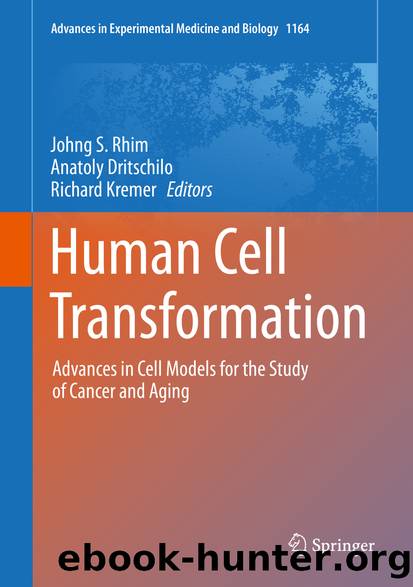Human Cell Transformation by Unknown

Author:Unknown
Language: eng
Format: epub
ISBN: 9783030222543
Publisher: Springer International Publishing
Alternative Splicing and Cancer
All components of the splicing process are tightly regulated, and any alteration can lead to disease causation and progression. The involvement of splicing dysregulation in oncogenic processes is known to activate oncogenes and inactivate tumor suppressors . Gene expression program changes via aberrant splicing in cancer cells select for functional changes that promote the malignant progression of the tumor [53]. Modifications in the splice sites or splicing machinery can lead to DNA damage, genomic instability, changes in epigenetics, alterations in transcriptional elongation, and changes in gene expression, thus helping to promote any of the “hallmarks of cancer” [54–56]. Splice variants are being used to characterize tumor subtypes and are targets of interest for cancer biomarkers and therapeutics [57]. Due to the potential for functional differences, individual AS variants need to be studied separately to better understand each variant’s role in disease progression. In addition, an understanding of the overall splicing changes, as a change in one trans-acting factor can affect the splicing of hundreds of transcripts, will be instrumental in identifying the role of AS in cancer.
The Cancer Genome Atlas (TCGA) data have been used to identify genome-wide AS events in cancer versus normal tissues and between different tumor subtypes and stages. Globally, AS events occur more frequently than somatic mutations in driver genes. AS also occurs more often in cancer-related pathways and in genes that are frequently mutated in cancers [58, 59]. Analysis of TCGA data has also identified key somatic mutations in splice sites that affect exon–intron boundaries, resulting in changes in expression of oncogenes and tumor suppressors in cancer [60]. In general, splicing of proto-oncogenes generates constitutively active or gain of function variants that confer an increased oncogenic advantage. Synonymous mutations, which can alter splice sites, are also more highly enriched in oncogenes. Conversely, AS of tumor suppressors can introduce premature stop codons and altered reading frames, resulting in decreased protein levels via nonsense-mediated decay or decreased function. Cancer cells have increased levels of intron retention in tumor suppressor transcripts which promote premature termination, nonsense-mediated decay, and tumor suppressor inactivation [61–63]. Mutations in splice sites or splice site choice can result in isoform switching or generation of novel splice variants [64]. Thus, somatic mutations in key genes or splice sites involved in AS may be a major driver in many cancers.
Differential splicing can generate variants with opposing functions or shift the balance between two isoforms. For example, while the full-length isoform of caspase-9 is pro-apoptotic, a shorter isoform missing exons 3–6 is anti-apoptotic and has been identified in cancers, including non-small cell lung carcinoma [65]. SRSF1, which is overexpressed in many cancers, binds within intron 6 to promote inclusion of exons 3–6 to generate the long variant [66]. Conversely, hnRNPL binds an ESS in exon 3 and induces splicing exclusion of exons 3–6 to generate the short variant [67]. Kinases such as AKT are predicted to phosphorylate and activate both SRSF1 and hnRNPL [68]. The known tumor suppressor gene TP53 has over seven different splice variants that have been detected in a variety of cancers [69].
Download
This site does not store any files on its server. We only index and link to content provided by other sites. Please contact the content providers to delete copyright contents if any and email us, we'll remove relevant links or contents immediately.
Becoming by Michelle Obama(9290)
The Last Black Unicorn by Tiffany Haddish(5075)
Beartown by Fredrik Backman(4415)
Man's Search for Meaning by Viktor Frankl(3631)
The Book of Joy by Dalai Lama(3217)
In a Sunburned Country by Bill Bryson(2946)
The Choice by Edith Eva Eger(2895)
The Five People You Meet in Heaven by Mitch Albom(2841)
Full Circle by Michael Palin(2771)
The Mamba Mentality by Kobe Bryant(2667)
The Social Psychology of Inequality by Unknown(2309)
Book of Life by Deborah Harkness(2263)
The Checklist Manifesto by Atul Gawande(2202)
Less by Andrew Sean Greer(2188)
The Big Twitch by Sean Dooley(2043)
No Room for Small Dreams by Shimon Peres(1991)
No Ashes in the Fire by Darnell L Moore(1981)
A Burst of Light by Audre Lorde(1980)
Imagine Me by Tahereh Mafi(1920)
